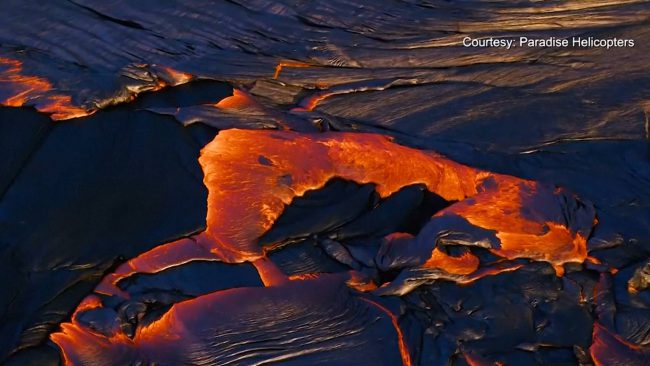A rare phenomenon known as a landspout occurred above Hawaii’s Kīlauea volcano on Thursday, and a photographer caught the entire event on camera as streams of lava poured from the mountain.

Mick Kalber was flying over the volcano with the helicopter tour company Paradise Helicopters, which he’s done for the past four years, and after finding a large amount of lava flows they went down the Pali — a very steep cliff on the volcano before heading out to the ocean.
READ MORE: Indonesia’s Mount Sinabung volcano unleashes towering ash column
“We wanted to go to the Pali to see what was happening,” Kalber said, “and that’s when we spotted the vortices or the landspouts and it was amazing.”
“We’ve seen that at the ocean, when a lot of lava goes in fast into the water, it creates that same phenomenon. It will swirl and it will make this clockwise motion and it will sometimes spin off vortices,” Kalber added, “but we’ve never seen them over land before.”
Kalber said he guessed some of the spouts rotating across the land were “hundreds of feet tall”, which came after lava flow — also caught on camera — scorched sections of the volcano’s eastern rift zone last week.

He said he’s lived on the island for the past 35 years and been documenting the volcano “within that time,” flying with various helicopter companies during that period.

Get daily National news
WATCH: Video shows stunning eruption of Philippines volcano at night

Kīlauea volcano is the most active of the state’s five volcanoes and has been erupting since 1952. It’s erupted 34 times since, and its activity has been continuous since January of 1983.
A landspout is considered a tornado, according to the National Oceanic and Atmospheric Administration, but it is specifically known as a “non-supercell tornado.”
The vortices have a narrow condensation funnel that most often forms while the thunderstorm cloud is still growing, but while there is no rotating updraft. They’re most often known for forming from the bottom-up instead of descending from a wall cloud.
Scott Sutherland with The Weather Network says they often form when a surface boundary is present, such as a cold front or lake breeze front, and the surface winds converge towards it, “blowing in from different directions on either sides of the boundary.” It then causes small vortices to form when the winds converge.
READ MORE: Philippine volcano Mount Mayon spews lava 3 kilometres from crater

The landspouts, which are rare in Hawaii, were the result of intense wind and high humidity in the area, Big Island Video News reported.
According to Kalber, landspouts and waterspouts are fairly similar, though the former may spin a bit more slowly.
He said they also saw one other unexpected sight as they were leaving the volcano — a pink rainbow, “which we’ve never seen before.”
— With a file from Reuters








Comments